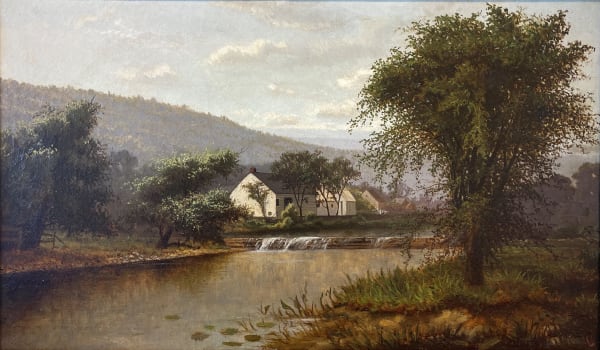Works
Biography
Ralph Blakelock was born in New York City in 1847. He was the son of an English-born physician and he first studied medicine, but his love of music and art led him away from medicine. He graduated from the College of the City of New York, studied briefly at Cooper Union and at the Free Academy of the City of New York. In 1867, he first exhibited at the National Academy of Design. As a young man, he traveled out West for three years and lived among various indigenous tribes, and many of his later works evoked memories of that journey. A tiny man (less than five feet tell, under ninety pounds) he became the father of eight children and he soon crumbled under the pressure of trying to support such a large family.
Blakelock was attracted to the Hudson River painters, Albert Pinkham Ryder's work, and the life of Native Americans which he observed between 1869 and 1871 on an extensive trip that included California, the upper Pacific Coast and down to Panama and Jamaica. Depicting wilderness areas of the American West, he brought the Hudson River style of painting with expensive vistas that were poetic and visionary. It is said that his real travels were introspective from which he created moody, often dark landscapes that did not satisfy the public taste for uplifting Hudson River style painting. He was ahead of popular taste and his work was largely overlooked.
After being forced by a collector into selling one of his moonlight canvases for $200, less than half his normal price, Blakelock took to wandering the streets of New York dressed in Native American garb. Then, in utter financial distress, he began manufacturing his own money: million dollar bills decorated with miniature landscapes and his own portrait in the middle. When he tried to cash one of these bills at a bank, he was finally locked up and sent to an asylum in Brooklyn and later to a hospital in upstate New York, where he spent the last 25 or 30 years of his life. In the hospital he continued to paint every day, using whatever materials were available: window shades, cigar boxes, pieces of cardboard.
By that time, his wife and children had moved to a rural shack in the Catskills (not far from where Thomas Cole had done some of his finest work) and were reduced to living on $50 a year. Mrs. Blakelock was so poor that she could not even afford to visit her husband. In the early 1900s, there was a sudden revival of interest in Blakelock's work, and one of his pictures (the same one that he had sold for $200 in the 1890s) was sold at an auction for almost $14,000 - one of the highest prices paid for a work by a living artist at the time. The irony was that Blakelock and his family never saw a penny from the sale. Forgeries of his works sold well, competing with his own in an active market. Blakelock died in a mental hospital in 1919.
Blakelock was attracted to the Hudson River painters, Albert Pinkham Ryder's work, and the life of Native Americans which he observed between 1869 and 1871 on an extensive trip that included California, the upper Pacific Coast and down to Panama and Jamaica. Depicting wilderness areas of the American West, he brought the Hudson River style of painting with expensive vistas that were poetic and visionary. It is said that his real travels were introspective from which he created moody, often dark landscapes that did not satisfy the public taste for uplifting Hudson River style painting. He was ahead of popular taste and his work was largely overlooked.
After being forced by a collector into selling one of his moonlight canvases for $200, less than half his normal price, Blakelock took to wandering the streets of New York dressed in Native American garb. Then, in utter financial distress, he began manufacturing his own money: million dollar bills decorated with miniature landscapes and his own portrait in the middle. When he tried to cash one of these bills at a bank, he was finally locked up and sent to an asylum in Brooklyn and later to a hospital in upstate New York, where he spent the last 25 or 30 years of his life. In the hospital he continued to paint every day, using whatever materials were available: window shades, cigar boxes, pieces of cardboard.
By that time, his wife and children had moved to a rural shack in the Catskills (not far from where Thomas Cole had done some of his finest work) and were reduced to living on $50 a year. Mrs. Blakelock was so poor that she could not even afford to visit her husband. In the early 1900s, there was a sudden revival of interest in Blakelock's work, and one of his pictures (the same one that he had sold for $200 in the 1890s) was sold at an auction for almost $14,000 - one of the highest prices paid for a work by a living artist at the time. The irony was that Blakelock and his family never saw a penny from the sale. Forgeries of his works sold well, competing with his own in an active market. Blakelock died in a mental hospital in 1919.
Enquire

